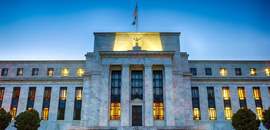One of the landmark developments influencing financial markets in the post-war era occurred 50 years ago, when the international monetary system shifted from a fixed to a floating exchange-rate regime. The demise of the Bretton Woods system of fixed exchange rates was a milestone event that marked the end of a prolonged period of low inflation, strong economic growth, and financial stability.
In his book “Three Days at Camp David,” Jeffrey Garten describes how President Nixon and his advisers reached an agreement to sever convertibility between the dollar and gold at $35 per ounce. When Nixon startled the world by announcing the decision on August 15, 1971, it set in motion a series of events that led to the breakdown of Bretton Woods.
Over the next three months, the U.S. Treasury negotiated the first devaluation of the dollar with its foreign counterparts. Treasury Secretary John Connally and Undersecretary Paul Volcker were concerned that a burgeoning U.S. trade deficit would increase steadily if the U.S. dollar kept the parities versus the Japanese yen and the key European currencies. They were also alarmed by a steady drain in U.S. holdings of gold that had fallen to just 25 percent of U.S. dollars held by foreign governments and central banks.
At the Smithsonian meeting in December, a compromise was reached in which the dollar was devalued by 8 percent. To maintain the Smithsonian parities, the Federal Reserve was obliged to tighten monetary policy while the central banks of the surplus countries were obligated to ease their policies. Both sides, however, were reluctant to do so and a standoff resulted.
The breaking point occurred in February 1973, when officials threw in the towel and closed the foreign exchange markets before the second dollar devaluation. This time, officials realized it was senseless to commit to a new set of exchange rate parities unless they could agree on policy actions to reduce inflation and trade imbalances. Thus, when the foreign exchange markets re-opened, currencies were free to fluctuate.
Looking back on what transpired, one can ask whether abandoning Bretton Woods was a good decision. Garten’s view is that it was soundly based. While he acknowledges criticisms of the decision, he argues that flexible exchange rates were good for America and proved to be compatible with growth of international trade and capital flows.
My own take is that Camp David was part of a larger set of forces that led to the breakdown. First, and most important, the U.S. went from being a low inflation country to become a high inflation country in the 1970s and early 1980s. This was the main reason that U.S. businesses had difficulty competing with their foreign counterparts. Also, a fixed exchange rate system became impractical when the reserve center was unstable.
But President Nixon failed to grasp that higher inflation stemmed from U.S. fiscal policy becoming expansionary during the Vietnam War era while the Federal Reserve kept interest rates artificially low. He pressured Fed Chairman Arthur Burns to hold off raising interest rates in the run-up to the 1972 elections, and Burns wound up supporting wage and price controls that were counterproductive.
Second, as international capital mobility proliferated, it became harder to maintain fixed exchange rates as capital flowed out of high inflation countries into ones with low inflation. This situation created problems for European policymakers, especially those in West Germany, Holland, and Switzerland, where the primary objective of monetary policy was to keep inflation low, typically at 2 percent or less.
Milton Friedman maintained that the shift to flexible exchange rates was desirable because it allowed countries with low inflation to regain control of their money supplies. For some economists and policymakers, however, the lapse into floating exchange rates meant deficit countries no longer were constrained by their balance of payments. Today, even the most ardent supporters of flexible exchange rates would concede that currency fluctuations have been much greater than expected.
Meanwhile, the international financial system has evolved into a hybrid system: The European Monetary Union has a common currency, the euro, which fluctuates freely against the U.S. dollar; China and Japan operate managed floats against the dollar while China controls capital flows; and many emerging economies peg their currencies to the dollar. The dollar, in turn, serves as the key reserve currency and numeraire for the system.
These arrangements have proved to be compatible with low inflation for the past 25 years. However, in my book “Global Shocks,” I highlight how the international financial system has been buffeted by a series of shocks that threatened financial stability. They include the Asian Financial Crisis, the tech bubble, the U.S. housing bubble that spawned the 2008 Global Financial Crisis (GFC), and now the COVID-19 pandemic.
The Fed views these shocks as isolated developments that can be contained by regulatory policies. But I maintain that asset bubbles have become more prevalent because central banks allow credit to be readily available at low interest rates when inflation is tame.
The problem has become even more acute since the GFC, as central banks undertook large-scale purchases of government debt and mortgage-backed securities. The Fed has been unable to wean itself off unorthodox monetary policies for the past 13 years. As a result, the main uncertainty today is whether the Fed’s policies will sow the seeds for higher inflation or foster bubbles in equities and housing.
My view is that the Fed may tolerate higher inflation in the near term. But it is unlikely to make the same mistake as in the 1970s when inflation spiraled out of control. If so, the dollar will continue to serve as the world’s premier currency for the foreseeable future as there is no viable alternative to it.
A version of this article was posted to TheHill.com on August 2, 2021.
In his book “Three Days at Camp David,” Jeffrey Garten describes how President Nixon and his advisers reached an agreement to sever convertibility between the dollar and gold at $35 per ounce. When Nixon startled the world by announcing the decision on August 15, 1971, it set in motion a series of events that led to the breakdown of Bretton Woods.
Over the next three months, the U.S. Treasury negotiated the first devaluation of the dollar with its foreign counterparts. Treasury Secretary John Connally and Undersecretary Paul Volcker were concerned that a burgeoning U.S. trade deficit would increase steadily if the U.S. dollar kept the parities versus the Japanese yen and the key European currencies. They were also alarmed by a steady drain in U.S. holdings of gold that had fallen to just 25 percent of U.S. dollars held by foreign governments and central banks.
At the Smithsonian meeting in December, a compromise was reached in which the dollar was devalued by 8 percent. To maintain the Smithsonian parities, the Federal Reserve was obliged to tighten monetary policy while the central banks of the surplus countries were obligated to ease their policies. Both sides, however, were reluctant to do so and a standoff resulted.
The breaking point occurred in February 1973, when officials threw in the towel and closed the foreign exchange markets before the second dollar devaluation. This time, officials realized it was senseless to commit to a new set of exchange rate parities unless they could agree on policy actions to reduce inflation and trade imbalances. Thus, when the foreign exchange markets re-opened, currencies were free to fluctuate.
Looking back on what transpired, one can ask whether abandoning Bretton Woods was a good decision. Garten’s view is that it was soundly based. While he acknowledges criticisms of the decision, he argues that flexible exchange rates were good for America and proved to be compatible with growth of international trade and capital flows.
My own take is that Camp David was part of a larger set of forces that led to the breakdown. First, and most important, the U.S. went from being a low inflation country to become a high inflation country in the 1970s and early 1980s. This was the main reason that U.S. businesses had difficulty competing with their foreign counterparts. Also, a fixed exchange rate system became impractical when the reserve center was unstable.
But President Nixon failed to grasp that higher inflation stemmed from U.S. fiscal policy becoming expansionary during the Vietnam War era while the Federal Reserve kept interest rates artificially low. He pressured Fed Chairman Arthur Burns to hold off raising interest rates in the run-up to the 1972 elections, and Burns wound up supporting wage and price controls that were counterproductive.
Second, as international capital mobility proliferated, it became harder to maintain fixed exchange rates as capital flowed out of high inflation countries into ones with low inflation. This situation created problems for European policymakers, especially those in West Germany, Holland, and Switzerland, where the primary objective of monetary policy was to keep inflation low, typically at 2 percent or less.
Milton Friedman maintained that the shift to flexible exchange rates was desirable because it allowed countries with low inflation to regain control of their money supplies. For some economists and policymakers, however, the lapse into floating exchange rates meant deficit countries no longer were constrained by their balance of payments. Today, even the most ardent supporters of flexible exchange rates would concede that currency fluctuations have been much greater than expected.
Meanwhile, the international financial system has evolved into a hybrid system: The European Monetary Union has a common currency, the euro, which fluctuates freely against the U.S. dollar; China and Japan operate managed floats against the dollar while China controls capital flows; and many emerging economies peg their currencies to the dollar. The dollar, in turn, serves as the key reserve currency and numeraire for the system.
These arrangements have proved to be compatible with low inflation for the past 25 years. However, in my book “Global Shocks,” I highlight how the international financial system has been buffeted by a series of shocks that threatened financial stability. They include the Asian Financial Crisis, the tech bubble, the U.S. housing bubble that spawned the 2008 Global Financial Crisis (GFC), and now the COVID-19 pandemic.
The Fed views these shocks as isolated developments that can be contained by regulatory policies. But I maintain that asset bubbles have become more prevalent because central banks allow credit to be readily available at low interest rates when inflation is tame.
The problem has become even more acute since the GFC, as central banks undertook large-scale purchases of government debt and mortgage-backed securities. The Fed has been unable to wean itself off unorthodox monetary policies for the past 13 years. As a result, the main uncertainty today is whether the Fed’s policies will sow the seeds for higher inflation or foster bubbles in equities and housing.
My view is that the Fed may tolerate higher inflation in the near term. But it is unlikely to make the same mistake as in the 1970s when inflation spiraled out of control. If so, the dollar will continue to serve as the world’s premier currency for the foreseeable future as there is no viable alternative to it.
A version of this article was posted to TheHill.com on August 2, 2021.



















